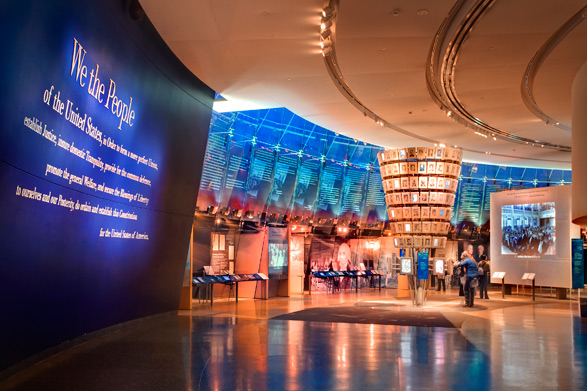Heritage has recently become a major trend within museums. Many newer museums now emphasize a connection to the past as a way to lure in new visitors and bringing new allure to visiting historical sites. As Heritage author, Steven Hoelscher describes it, "Heritage is a mode of understanding and utilizing the past that is, at its very core, deeply partisan and intensely felt."(pg.200) Heritage from this description is open to basically anyone that identifies with certain communites, countries, nations, etc. Heritage is easily accessible and easy to relate to because it is open for interpretation to all that wish to interpret it. Interestingly enough in his essay, Hoelscher points out that the practice of relaying heritage to the masses takes work. It involves taking the past and cultivating it to fit the "proper image" of what the past should be. This is an interesting dichotomy because that would mean heritage is not always open to all that wish to identify with it. This also makes it seem as if heritage excludes what it finds "less desirable" memories or people.
The Constitution Center was an interesting study in this new trend of heritage tourism, it was quite a visual and engaging experience. Of heritage on displays, Holscher references MacDonald whose idea of the display of heritage is, " ...a heritage display or representation is "intentionally, a clutural explicating device."(page. 204). This is definitely the case with the Constitution Center. There was the replication of the signers of the Constitution who stood at their actual heights provided a really different view of the signers, they seemed more life like and real. After that was the EPIC introduction which (shamefully) reduced me to pride induced tears. Yeah it was intense. From there was the very visual linear view of American history which was ever-changing. That exhibit especially was engaging because there were so many a experiences a vistior to the Consitution Center could have. It was a very democratic layout because how much or how little a visitor would like to learn is completely up to them. The most notable part of the linear American history was the way it moved rapidly through time giving the visitors a crash course in all things American. Time, according to Holscher, is essential to heritage. "Second, and just as revealing, is the processual nature of heritage, a social process that is contintually unfolding, changing and transforming."(pg. 206). Heritage has become a very essential trend in tourism because many people feel they are included within it and are actively shaping their own heritage every day.
The President's House across the street was a very poorly planned site in Olde City. Not only does it have the misfortune of being an open air establishment but the narrative inside makes little to no sense. It seems to be a very scatter-brained attempt at telling visitors the significance of the house. And in fact it is very important because it once housed the very first presidents. Also, the basement which is displayed pretty terribly is a place where the presidents once housed slaves. This is a place that is an example of heritage being excluded because it does not fully serve as a place for people to identify with or learn from.
**Found this on the Iragi museum that was destroyed in 2003(referenced in Hoelscher's article), it has been finally restored. http://www.msnbc.msn.com/id/45484016/ns/world_news-christian_science_monitor/
Tuesday, November 29, 2011
Friday, November 4, 2011
Entertainment vs. Historical Accuracy
The Eastern State Penitentiary has been a main topic of interest all over Philadelphia and the world. After attending the "Haunted Histories' talk I was extremely interested in seeing the penitentiary in all its abandoned glory. The first thing I noticed aesthetically speaking is the gargoyles which immediately helped the ominous atmosphere of Eastern State. Then I found out something interesting....they weren't REAL. They were apart of the Haunted attraction that the penitentiary extended past Halloween. That was a bit annoying because any uninformed passerby would probably think that they were a part of the architecture. The tour itself was really informative thanks to an engaging and funny tour guide. Although, I could tell he was sizing us up at the beginning to see what KIND of tour we would be interested in. Basically that means the tours Eastern State gives based on the audience that attends. Our tour guide knew that were thinking critically about Eastern State so he gave us a tour that pointed out criticisms and failures of Eastern State's prison system and the prison system that the United States still has today. While we were outside waiting for our tour, there was an older group of visitors and I wonder what kind of tour they got, did their tour guide glaze over Eastern State's and the United States prison failures and instead just marvel at the architectural wonders at Eastern? (anecdotally: At most of the museums we have been, I've noticed the dichotomy of old ideas vs. new ideas. It is apparent that some people want to take museums to another level and other people would like to imagine as the stable place to gain knowledge. This, in my opinion, is having a negative effect on the progress of the public history field because society is changing and it is important to re-imagine museums so they appeal to a newer society.) Anyway, Eastern State does a very good job of KNOWING its history and the fact that, "Terror Behind the Walls" is helping with that is good and productive endeavor. And it is apparent to even to the average visitor that Eastern is trying to preserve the historical meaning of Eastern. Also, Eastern State challenges its visitors to think critically about prison systems and to look at whether or not things have gotten worse or better.
Subscribe to:
Posts (Atom)


